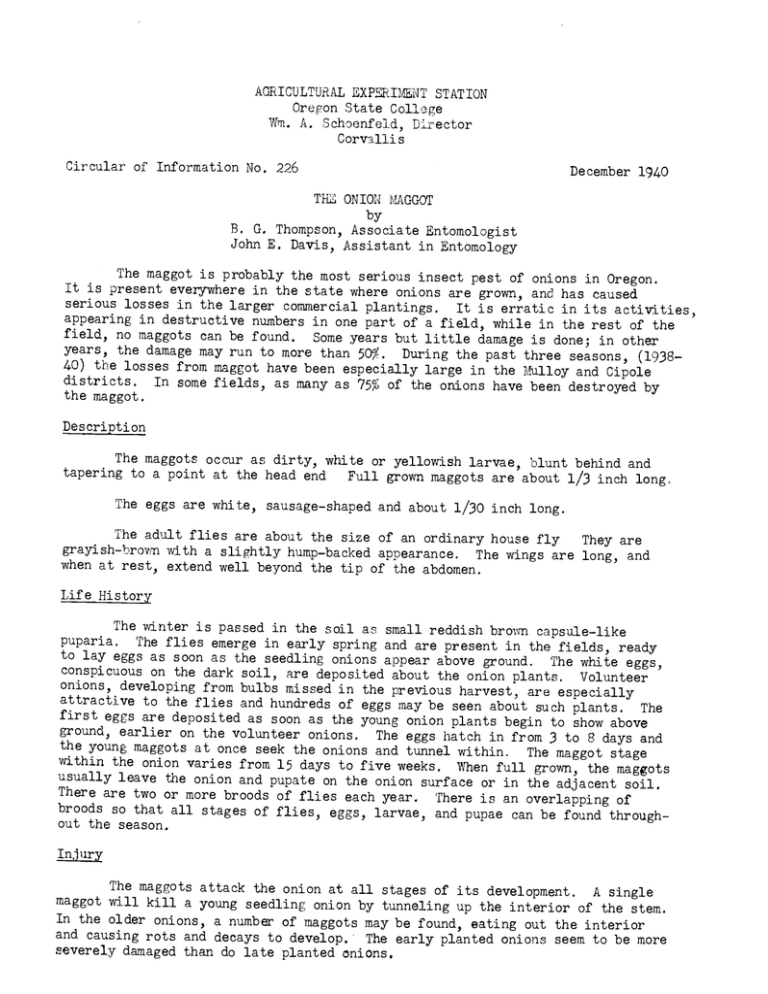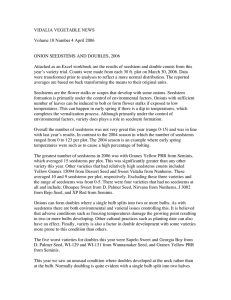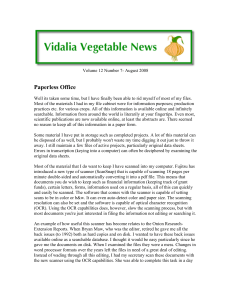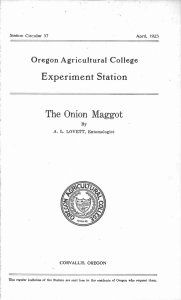AGRICULTURAL EXPERINT STATION
advertisement

AGRICULTURAL EXPERINT STATION Oregon State College Wm. A. Schoenfeld, Director Corvallis Circular of Information No. 226 December 1940 TFII ONION MAGGOT by B. G. Thompson, Associate Entomologist John E. Davis, Assistant in Entomology The maggot is probably the most serious insect pest of onions in Oregon. It is present everywhere in the state where onions are grown, and has caused serious losses in the larger commercial plantings. It is erratic in its activities, appearing in destructive numbers in one part of a field, while in the rest of the field, no maggots can be found. Some years but little damage is done; in other years, the damage may run to more than 50%. During the past three seasons, (193840) the losses from maggot have been especially large in the Mulloy and Cipole districts. In some fields, as many as 75% of the onions have been destroyed by the maggot. Description The maggots occur as dirty, white or yellowish larvae, blunt behind and tapering to a point at the head end Full grown maggots are about 1/3 inch long. The eggs are white, sausage-shaped and about 1/30 inch long. The adult flies are about the size of an ordinary house fly They are grayish-brown with a slightly hump-backed appearance. The wings are long, and when at rest, extend well beyond the tip of the abdomen. Life History The winter is passed in the soil as small reddish brown capsule-like The flies emerge in early spring and are present in the fields, ready to lay eggs as soon as the seedling onions appear above ground. The white eggs, conspicuous on the dark soil, are deposited about the onion plants. Volunteer onions, developing from bulbs missed in the previous harvest, are especially attractive to the flies and hundreds of eggs may be seen about such plants. The first eggs are deposited as soon as the young onion plants begin to show above ground, earlier on the volunteer onions. The eggs hatch in from 3 to 8 days and the young maggots at once seek the onions and tunnel within. The maggot stage within the onion varies from 15 days to five weeks. When full grown, the maggots usually leave the onion and pupate on the onion surface or in the adjacent soil. There are two or more broods of flies each year. There is an overlapping of broods so that all stages of flies, eggs, larvae, and pupae can be found throughout the season. puparia. Injury The maggots attack the onion at all stages of its development. A single maggot will kill a young seedling onion by tunneling up the interior of the stem. In the older onions, a number of maggots may be found, eating out the interior and causing rots and decays to develop. The early planted onions seem to be more severely damaged than do late planted onions. 2. Control Until recently, no very practics conbrol was knorn for onion maggot. Experiments begun by the Entomology department of the Oregon Experiment Station in 1930 and carried out on a more extensive scale in 1939 and 1940, show that mercurous chloride, (calomel) when drilled in with the onion seed, gave excellent control of the onion maggot. The calomel is thoroughly mixed with the seed at the rate of two pounds of calomel to one pound of onion seed and planted in the usual way. Due to the extra bulk caused by the addition of the calomel, it is necessary to open the planter up one notch to give the required amount o± seed; for example, if it is desired to plant three pounds of seed per acre, the planter is set at 3 pounds per acre. Planters equipped with metal burr agitators handled the calomel seed mwture without difficulty, while planters with brush agitators clogged badly and did not plant the seed evenly. In our experimental work, better maggot control was obtained when the calomel treated seed was shallow planted. The following table gives the results o± our experiments to determine the effect on the stand of depth of planting calomel treated seed. Planted 3/8 inch deep Planted 1 inch deep Calomel treated seed; 2# calomel, l# seed 2500 onions in a 500 ft. row 516 onions in a 500 ft. row Untreated check 265 onions in a 500 ft. row 268 onions in a 500 ft. row The following table gives the number of onions in 500 lineal feet selected at random from a number of our experimental plots in the Mulloy and Cipole onion growing sections. Plot No. 1 2 3 4 5 6 Treated Untreated 2500 2450 1179 4790 2121 2699 265 230 106 95 099 130 It will be seen from this table that on many- of the plots there were at least ten times as many onions as on the corresponding untreated plot. CAUTION: There was a reduction in the stand of onions when the formaldehyde treatment for smut was used with caomel treated seed. This loss was greatest where an excessive amount of formaldehyde was used, or when the seed was planted deeper than 1/2 inch. 11here necessary to use both smut and maggot control, care should be exercised to plant shallow and use only the required amount of formaldehyde. 14 L Onions produced on 1/20 acre untreated check plot. Onions produced on 1/20 acre Calomel treated plot. A. B. : : 1 4 A. B. Calomel treated plot. Untreated check plot Note heavy growth and good stand. unprofitable stand and growth.




